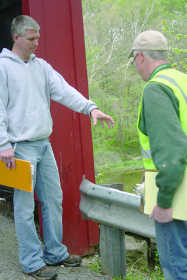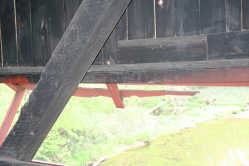Covered bridge on long road to rehab

No speed limit is needed as the wheels of government cross Baker's Camp Covered Bridge. As always, they turn slowly.
The county learned of a pair of federal grant disbursements totaling $980,000 last summer that will fund 80 percent of a $1.225 million rehabilitation project for the 111-year-old structure. However, work on the bridge will not start until spring 2014.
Meanwhile, the Putnam County will go through a series of checkpoints and inspections on the covered bridge on County Road 650 North over Big Walnut Creek in Floyd Township.
The most recent of these was a Thursday, April 19 field inspection with Clark Dietz Engineers. County Highway co-supervisors Jim Smith and Clint Maddox and County Commissioner Gene Beck met with Kevin Loiselle and Bobby Chandler of Clark Dietz.
One of the main concerns discussed at the meeting was the damage often caused to the portals by vehicles too tall to pass through the bridge.
While there is no way to completely guard against the carelessness of motorists in oversized vehicles, Loiselle and Chandler suggested that height limits be posted with the 8-ton weight limit already posted on each end of the bridge.
Other solutions to the problem will also be explored.
The point of the rehabilitation project is to upgrade the existing bridge while maintaining its historic character. As such, every step is taken to preserve existing elements of the bridge. When replacements are made, the goal is for them to fit in as seamlessly as possible.
The roof and siding will have to undergo serious repairs, and the material to be used to replace the current tin roof was a topic of discussion. The possibilities exist both of another tin roof or of wooden shingles.
Except in the case of structurally weakened elements, the timber frame of the bridge should remain largely unchanged by the construction. The stone abutments beneath the bridge will also be addressed by tuck-pointing their joints.
Other improvements will include painting the siding, truss members, arches and cross bracing and adding a fire retardant to all wooden parts of the bridge.

One aesthetic change not previously discussed was the suggestion of timber guardrails at each end of the bridge, replacing the current steel guardrails.
The bridge is unlikely to have had any sort of guardrail in the less safety-conscious climate of 1901, but timber looks more consistent with the bridge's rural ambience.
More inspections are on the agenda for the remainder of 2012, with additional engineering and other steps set for 2013. Contract letting through INDOT is scheduled for January 2014, with construction to begin that spring.
The construction is expected to take six months.
